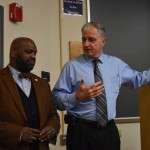
Investment returns on educational endowments, such as the ones at Boston University, averaged 15.8 percent for the 2014 fiscal year, according to a Monday preliminary report by the National Association of College and University Businesses Officers and Commonfund Institute.
The report looked at endowment size and asset allocation for endowments from 426 schools across the country. It was one of the most comprehensive annual reports on the investment management and governance practices and policies of institutions of higher education across the United States, according to a Monday press release.
“It is an authoritative report about what is going on in endowment investing. Colleges participate every year,” said William Jarvis, managing director of Commonfund. “The reason we publish this is as a service to policy makers, the educational sector and to the general public.”
NACUBO and Commonfund reported an 11.7 percent average return for the same schools surveyed in 2013, the release stated.
“These higher returns will be a great benefit to students and faculty at colleges and universities,” said NACUBO President and CEO John Walda in the release. “Additional resources generated by endowments will continue to help fund vital research, financial aid and other programs at our institutions.”
BU Chief Investment Officer Clarissa Hunnewell, said endowment can be spent on scholarships, financial aid, research, program funding and standard income.
“The endowment is a diversified investment portfolio invested on a global basis,” she said in an email. “Any permanently restricted endowment gifts raised by the capital campaign will be added to the Pooled Endowment.”
BU saw an increase in market value of 18.4 percent from 2012 to 2013, according to a NACUBO endowment report from 2013.
Roy Chernus, a spokesman for Commonfund from the public relations firm Gibbs & Soell, said other factors outside of investment return, such as withdrawals, payments, payment fees and donor contributions, are included in the market value of an educational institution.
Several students said educational endowments can be used for ways that both promote the university and help students.
Kembo Matungulu, a sophomore in the College of Arts and Sciences, said the university’s endowment is important because it can help students cover the cost of tuition.
“I know a ton of people who wouldn’t be able to attend BU if it weren’t for financial aid,” she said. “Tuition is expensive, so I am not surprised that I know many people at BU who are here under financial aid or scholarships.”
Stephanie Neville, a sophomore in Sargent College of Health and Rehabilitation Sciences, said a large endowment can also be useful to fund university research.
“Probably all elements funded from endowments are important, in terms of BU, because we do a lot of research, and we are so science-based,” she said.
Luming Tan, a junior in CAS, said institutions should spend more of its endowment on financial aid or look for other ways to reduce tuition costs.
“Of all the sectors that endowments can be spent on, I think financial aid is most important,” she said. “As an international student, we pay the full tuition, as we are not eligible for financial aid. Institutions should give back to their students.”




